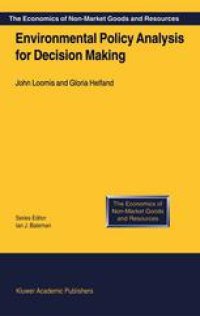
Ebook: Environmental Policy Analysis for Decision Making
- Tags: Environmental Management, Ecotoxicology, Economic Policy, Environmental Economics, Political Science
- Series: The Economics of Non-Market Goods and Resources 1
- Year: 2003
- Publisher: Springer Netherlands
- Edition: 1
- Language: English
- pdf
1. ENVIRONMENTAL POLICY ANALYSIS: WHAT AND WHY? Why environmental policy analysis? Environmental issues are growing in visibility in local, national, and world arenas, as a myriad of human activities leads to increased impacts on the natural world. Issues such as climate change, endangered species, wilderness protection, and energy use are regularly on the front pages of newspapers. Governments at all levels are struggling with how to address these issues. Environmental policy analysis is intended to present the environmental and social impacts of policies, in the hope that better decisions will result when people have better information on which to base those decisions. Conducting environmental policy analysis requires people who understand what it is and how to do it. Interpreting it also requires those skills. We hope that this book will increase the abilities, both of analysts and of decision-makers, to understand and interpret the impacts of environmental policies. Policy analysis books almost invariably begin by pointing out that policy analysis can take many forms. This book is no different. As you will see in Chapter 1, we consider policy analysis to be information provided for the policy process. That information can take many forms, from sophisticated empirical analysis to general theoretical results, from summary statistics to game theoretic strategies.
This book outlines the roles of environmental policy analysis in design and evaluation of a wide range of environmental policies. The book emphasizes methods and tools for performing policy analysis such as benefit-cost analysis as well as supporting tools such as non-market valuation (travel cost method, contingent valuation and hedonic pricing), input-output models, linear regression techniques, and linear programming/optimization models. Numerous real world examples illustrate how the techniques have been applied in actual policy analyses.